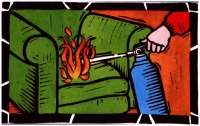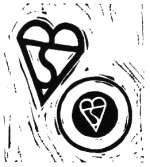How to choose and use
FIRE EXTINGUISHERS FOR THE HOME

A GUIDE TO FIRE EXTINGUISHERS AND FIRE BLANKETS IN THE HOME
FIRE KILLS
Each year nearly 700 people die from fire in their own home. A further 14,000 are injured. The best way to avoid this danger is to prevent fire from starting in the first place. But what should you do if you discover a fire in your home? You must get everyone out as quickly as possible and call the fire brigade.
However, you may discover a fire in its very early stages and think that you can deal with it yourself. The first thing that you should remember is that fire spreads very quickly. Even a small contained fire can quickly spread, producing smoke and fumes which can kill in seconds. If you are in any doubt do not tackle the fire, no matter how small.
You can put yourself at unnecessary risk by fighting the fire.
If in doubt get out, get the brigade out, stay out.
Before you tackle a fire . . . .
Many people put out small fires in their homes quite safely. Sadly, however, some people die or are injured by tackling a fire which is beyond their capablilities. Here is a simple home fire code to help you decide whether to put out or get out.
Only tackle a fire in its very early stages.
Always put your own and other people's safety first. Make sure you can escape if you need to and never let a fire block your exit.
Fire extinguishers are only for fighting a fire in its very early stages. Never tackle a fire if it is starting to spread or has spread to other items in the room or if the room is filling with smoke. Around 70% of fire deaths are caused by people being overcome by smoke and fumes.
If you cannot put out the fire or if the extinguisher becomes empty, get out and get everyone else out of the building immediately, closing all doors behind you as you go. Then telephone the fire brigade.
SAFETY MARKS - Buy wisely

Whatever type or make of fire extinguisher you choose, make sure it conforms to the appropriate British Standard (BS 5423 or BS 6165). Look for the Kitemark or the special BAFE mark.
Where to fix your extinguisher
Fix an extinguisher where you can reach it quickly. The best place is on an escape route, that is, near an outside door, or, on the route from the living areas to an outside door, or adjacent to a specific risk. It should be properly fixed to the wall at a height where it can be reached. Keep it out of the reach of children.
Fire extinguishers should be fixed where they can be easily seen. Fixing them inside cupboards or behind doors will only waste valuable time if a fire breaks out.
Do not place them over cookers or heaters or in places of extreme temperatures.
Maintenance
The manufacturer's instructions will tell you what you need to do to keep your extinguisher in good working order. After an extinguisher has been used, even if only partially, it must be recharged according to the manufacturer's instructions.
The extinguisher should be properly serviced once a year. you should use a company registered by the British Approvals for Fire Equipment.
BRITISH APPROVALS for FIRE EQUIPMENT
BAFE is a Government recognised national organisation. You can get details of approved products and advice from British Approvals for Fire Equipment, 48a Eden Street, Kingston upon thames, Surrey KT1 1EE (Tel : 0181-541 1950). They can also supply a list of companies approved by them to service portable fire extinguishers.
Fire Blankets
Fire blankets are made of fire resistant material. They are particularly useful for smothering fat pan fires or for wrapping round a person whose clothing is on fire. Fire blankets conforming to British Standard BS 6575 are suitable for use in the home. These will be marked to show whether they should be thrown away after use or used again after cleaning in accordance with the manufacturer's instructions.
A fire blanket or damp cloth should be used on a fat pan fire. Never use a fire extinguisher on a fat pan fire. Fire blankets should be kept in the kitchen.
|